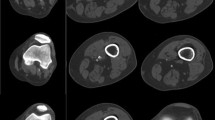Abstract
To evaluate the role of three-dimensional computed tomographic angiography (3D-CT) in peripheral artery bypass surgery, 49 patients with chronic lower limb ischemia underwent 3D-CT before and after a bypass operation. 3D-CT had a sensitivity of 96.8%, a specificity of 95.0% and an overall accuracy of 96.1% for the diagnosis of arterial and graft stenosis or obstructions. The ability to observe the acquired images at any angle was very useful for assessing the implanted graft in both aortoiliac and infrainguinal bypasses. Although these images equally identified arterial stenosis, obstruction, and the anastomotic morphology of bypass grafts as well as conventional angiography, the diagnostic accuracy was not helpful in the small arteries and grafts. 3D-CT is a low-invasive imaging method that is sufficient for forming strategies for bypass operations. In aortofemoral or femoropopliteal bypass surgery, 3D-CT thus provides sufficient imaging accuracy for bypasses up to the popliteal artery below the knee in patients with chronic limb ischemia.
Similar content being viewed by others
References
Gomes MN, Davros WJ, Zeman RK (1994) Preoperative assessment of abdominal aortic aneurysm: the value of helical and three-dimensional computed tomography. J Vasc Surg 20:367–376
Chuter TAM, Green RM, Ouriel K, DeWeese JA (1994) Infrarenal aortic aneurysm structure: implications for transfemoral repair. J Vasc Surg 20:44–50
Balm R, Eikelboom BC, Van Leeuwen MS, Noordzij J (1994) Spiral CT-angiography of the aorta. Eur J Vasc Surg 8:544–551
Summer DS (1985) Evaluation of noninvasive testing procedures: data analysis and interpretation. In: Bernstein EF (ed) Noninvasive diagnostic techniques in vascular disease, 3rd edn. Mosby, St. Louis, pp 861–889
Dalsing MC, Cikrit DF, Lalka SG, Sawchuk AP, Schulz C (1995) Femorodistal vein grafts: the utility of graft surveillance criteria. J Vasc Surg 21:127–134
Sladen JG, Gilmour JL (1981) Vein graft stenosis. Characteristics and effect of treatment. Am J Surg 141:549–553
Sasajima T, Kubo Y, Kokubo M, Izumi Y, Inaba M (1993) Comparison of reversed and in situ saphenous vein grafts for infragenicular bypass: experience of two surgeons. Cardiovasc Surg 1:38–43
Rubin GD, Walker PJ, Dake MD, Napel S, Jeffrey RB, McDonnell CH, Mitchell RS, Miller DC (1993) Three-dimensional spiral computed tomographic angiography: an alternative imaging modality for the abdominal aorta and its branches. J Vasc Surg 18:656–665
Sensier Y, Hartshorne T, Thrush A, Nydahl S, Bolia A, London NJM (1996) A prospective comparison of lower limb colour-coded duplex scanning with arteriography. Eur J Vasc Endovasc Surg 11:170–175
Carpenter JP, Baum RA, Holland GA, Barker CF (1994) Peripheral vascular surgery with magnetic resonance angiography as the sole preoperative imaging modality. J Vasc Surg 20:861–871
Prince MR, Narasimham DL, Stanley JC, Wakefield TW, Messina LM, Zelenock GB, Jacoby WT, Marx MV, Williams DM, Cho KJ (1995) Gadolinium-enhanced magnetic resonance angiography of abdominal aortic aneurysms. J Vasc Surg 21:656–669
White RA, Scoccianti M, Back M, Kopchok G, Donayre C (1994) Innovations in vascular imaging: arteriography, three-dimensional CT scans, and two- and three-dimensional intravascular ultrasound evaluation of an abdominal aortic aneurysm. Ann Vasc Surg 8:285–289
Author information
Authors and Affiliations
Rights and permissions
About this article
Cite this article
Ishikawa, M., Morimoto, N., Sasajima, T. et al. Three-dimensional computed tomographic angiography in lower extremity revascularization. Surg Today 29, 243–247 (1999). https://doi.org/10.1007/BF02483014
Received:
Accepted:
Issue Date:
DOI: https://doi.org/10.1007/BF02483014




